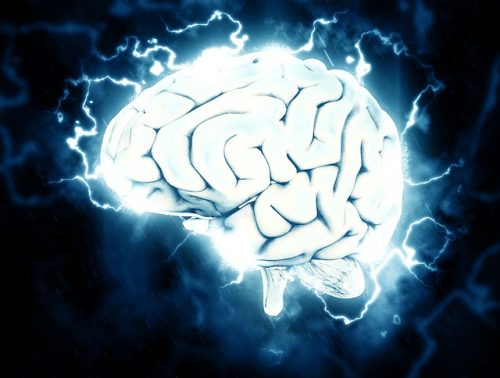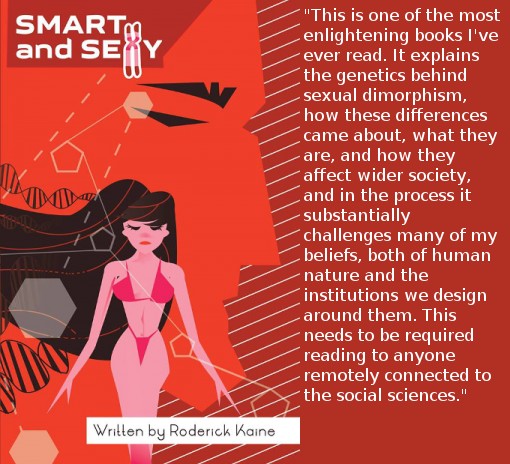
As you know from my last post, altright.com is down and it is unclear when it will be coming back. Arktos helped run altright.com and also hosted the excerpts for their books on that site. This includes excerpts from my book, Smart and sexy which is on gender differences in intelligence. As such, I have decided to rehost those excerpts here on atavisionary.com. Please enjoy, and if you like this consider purchasing Smart and SeXy as there is much more where this came from.
Cambridge University autism researcher Simon Baron-Cohen, the cousin of comedian Sacha Baron-Cohen, advances the idea that Autism Spectrum Conditions (ASC) including Asperger’s syndrome can be at least partially explained as being the expression of an “extreme male brain” (EMB) that results from unusually high concentrations of testosterone during fetal development.
Increased fetal testosterone affects brain morphology, which results in increasing sexual dimorphism in a variety of brain regions. Excessive testosterone triggers super-normal male-typical development of the brain. This hypothesis is consistent with the fact that ASCs have a heavy male bias. It is theoretically easier to transition from normal male testosterone levels to excessive levels than it is to go from normally low levels in females to excessive levels. Further evidence for this theory includes recent research showing that women with Polycystic Ovary Syndrome, a condition which leads to elevated levels of Androgens in the fetal environment, have a 59% increase in the risk of having children with an ASC.i In support of this idea, in traditional autism, the gender disparity ranges from 4:1 to 8:1 male to female sufferers depending on the study. For Asperger’s specifically, the ratio may be as high as 11:1.
Morphological evidence offers persuasive support of EMB theory. In cases where there is sexual dimorphism in brain structure, individuals with Autism tend to have a more extreme expression of the male typical phenotype. For example, male brains in infants are on average larger than female brains, and autistic children tend to have even larger brains than the male average. In normal males, larger brain size is mostly a function of increased growth of white matter and to the extent that an autist’s brain is larger than the male average it is also a function of increased white matter growth. Specific brain regions which are normally sexually dimorphic demonstrate the same trend where autists tend to be exaggerated from the male average. For example, the amygdala is larger in males than females, and larger still in autists than developmentally normal males. Given that fetal testosterone has been robustly implicated in driving male typical dimorphisms, it is quite probable that an excess of the hormone during development accounts for the exaggerated male typical phenotypes found in autists.Though autists are popularly thought of as having low intelligence, autism has been identified in individuals at all levels of intelligence, including at high levels.ii It is likely that the peak of autism diagnoses at low IQ levels is at least partially a result of ascertainment bias; low IQ being the trigger for seeing specialists who perform tests and make the diagnosis. Concurrent appearance of autistic traits with unrelated genetic factors leading to lowered IQ or other neurological vulnerabilities thus greatly increases the probability of diagnosis and is not necessarily evidence of a common cause.iii Autistic individuals with high IQ are also likely better able to compensate for their atypical neural functioning by the time they reach adulthood and are thus less likely to ever be diagnosed. Returning to the analogy of the tool-set and tool user, autist’s possess a series of tools which are very poorly designed for social interactions. An exceptionally competent tool user might be able to overcome this disadvantage through raw intelligence. The extra vulnerability of males to neurological disorders resulting from hemizygous exposure on X linked cognitive genes could be expected to work synergistically with elevated levels of testosterone during normal male fetal development, especially if those levels are atypically high, to cause the predominance of males diagnosed with an Autism spectrum disorder.
As might be expected from an exaggerated male brain structure, autists tend to have an exaggerated male typical cognitive profile. In other words, they have a “spiky” profile on intelligence test batteries. They tend to perform much more poorly on the sub-tests that require verbal skills and language processing and have ability peaks on sub-tests which emphasize spatial reasoning.ii, iv For example, in the highly visuospatial block design task (BDT) of the Wechsler test battery, 47% of autists have a peak compared to only 2% of the general population. The peak is typically between 1-3 standard deviations above the performance you would expect based on how they did on other tests (i.e., their baseline). In addition, about 50% of neurotypical individuals perform under their baseline IQ on this task, but less than 10% of autists perform under baseline.v Perhaps coincidentally, like autists, high intelligence individuals who aren’t diagnosed with autism also tend to display intellectual profiles with specific ability peaks.
One test, Raven’s Progressive Matrices (RPM), has been used to measure autistic intelligence independently of verbal skill. The test is highly visual and requires very little verbal instruction. It is widely regarded as one of, if not the best, single measures of intelligence:
The Raven’s Progressive Matrices has been empirically demonstrated to assay the ability to infer rules, to manage a hierarchy of goals, and to form high-level abstractions. Broadly recognized as a paramount metric of reasoning and problem solving, the Raven’s Progressive Matrices is believed to be a “paradigmatic” measure of fluid intelligence, and fluid-intelligence tasks are proposed to require coordinated executive function, attentional control, and working memory. The Raven’s Progressive Matrices occupies psychometric centrality among tests of cognitive ability; in Snow, Kyllonen, and Marshalek’s (1984)vi classic diagram, which summarizes the intercorrelations among numerous tests of cognitive ability, simple, domain-specific tests lie along the periphery, and Raven’s Progressive Matrices occupies the center, as the most complex and general single test of intelligence.vii
In a study comparing the performance of autists on the Wechsler test battery, which requires a great deal of language processing even for visual tests as a result of oral instruction, and the RPM found that autists performed on average 30 percentile points higher than would be expected from their Wechsler score. Individual scores ranged even higher than that up to a maximum of 94 percentile points better on the RPM.vii Compared with the neurotypical control group, autists are actually more efficient at solving some classes of items on the RPM. They were 23% faster at figural items and 42% faster at analytical items.viii This study provides persuasive support to the idea that autists preferentially use visuospatial specific strategies and brain regions to solve cognitive tests.viii There is evidence that locally oriented processing, likely due to enhanced white matter growth, and skewing towards the posterocentral occipital brain region play a large role in visuospatial ability peaks in autists as they are found to be enhanced in the large majority of the autistic population.v This is consistent with an exaggeration of normal male sexual dimorphism of enhanced white matter growth and dependence on the occipital region in visuospatial processing.People with Asperger’s syndrome do not display a visuospatial peak on the Wechsler as autists commonly do. When they do possess a peak it is generally on verbal items. Why those with Asperger’s should buck the trend with regards to the ability peaks in other autists isn’t clear. However, there are still important commonalities between autism and Asperger’s. Aspies display a similar trend, albeit less extreme, as autists when comparing RPM to their Wechsler test battery score in that they perform better on the RPM than might be expected from their overall Wechsler score. In addition, neurotypicals tend to have a loss or distortion of information as a result of mandatory hierarchies of processing in cognition. Autists and aspies both can maintain more accurate mental representations of the information in the environment when performing high level, complex tasks which leads to enhanced efficiency, and show more creative and independent thinking with regards to the specific type of information for which they have an ability peak; verbal information in the case aspies and perceptual information in the case of autists.iv
It is well-known that some autists, despite having social problems and difficulty functioning independently, often display some remarkable intellectual talents; especially when it comes to detailed memory of their favorite topic. The subset of autists with uncanny intellectual abilities used to be widely referred to as idiot savants to indicate both their lower level of overall functioning and their above average excellence in a particular narrow domain.
As part of the extreme male brain theory of autism, Simon Baron-Cohen proposes that there exist two dimensions by which humans can interpret the way the world works. The first dimension, empathizing reasoning, involves interpreting the goals of conscious agents and general theory of mind. Empathizing reasoning allows efficient inference of mental and emotional states in others and promotes the drive to respond with appropriate emotion and physical actions to those states. It must be noted that actual “empathy” does not necessarily have to play a large role in this sort of reasoning. It could just as easily and perhaps more accurately have been called “Machiavellian” reasoning. The major thrust of this form of reasoning is understanding the emotional states of others and responding to those states well; whether this knowledge is used to sympathize with others or pursue raw self interest is secondary.
The second dimension, systemizing reasoning, is defined as the drive and ability to analyze and construct rules for a particular system that can produce consistently predictable outputs from given inputs as a result of operational rules.ix It is especially effective at interpretation of non-agentative lawful systems such as are common in the natural world. Lawful systems are characterized by being highly predictable. Given a specific input, a lawful system can be expected to repeatedly have a consistent output after some operation takes place. Examples of highly lawful systems, approaching 100% lawfulness, would be things such as mathematical formulas, the functioning of engines, and the movement of celestial bodies. Given a perturbation of such systems, the resulting change or output can be predicted with the real-world results varying minimally from predication. Moderately lawful systems, such as meteorology, are also amenable to systemizing reasoning.
Systemizing requires that a system is held virtually constant while only changing one variable at a time during the process of data collection. Due to the inherent complexity and extraordinary variance of social situations it is virtually impossible to apply systemizing reasoning to navigation of social settings. Human beings have a high degree of variance in their personality and other psychological dispositions which makes them highly difficult to accumulate data on and subsequently make predictions about behavior in a rule-based way. A given input can and will likely result in a host of different outcomes in different people. Thus, human behavior is a highly unlawful system or at least it is of such complexity that it is beyond the human capability for systemizing at the rate at which social interactions actually happen.
Empathizing reasoning is more efficient in that it focuses on cues people give, especially non-verbally, to indicate their emotional state and thus allows the correct inference of that individual’s goals. It is possible to analogize empathizing reasoning to a pre-compiled software program or specially tailored hardware that comes pre-built in the human mind. Since it is too difficult to understand human behavior from day to day through consciously derived rule-based systems, innate instincts that are already optimized to understand and correctly respond to human behavior are more efficient.There are sex differences with regard to the degree upon which systemizing or empathizing reasoning are depended upon between genders and this likely reflects differences in the relative need each gender had of either type of system during evolutionary history. It is likely that the relative preference for either type of reasoning is underpinned by the same structural brain differences that lead to sexual dimorphisms in verbal and spatial reasoning. These various forms of reasoning may in fact all be facets of the same underlying cognitive phenomenon. In general, women tend to express a greater degree of empathizing (i.e., Machiavellian) reasoning than systemizing reasoning, while males demonstrate more systemizing reasoning. For example, women are better at recognizing faces than men, and are better at recognizing female faces than male faces. Fetal testosterone exposure, independent of gender, correlates positively with systemizing reasoning and negatively with empathizing reasoning. Since males normally have greater fetal testosterone, it is understandable why they tend to more commonly systemize. Like visuospatial reasoning, systemizing is correlated both with neuroanatomical features and university major choice and likely underlies the greater male participation in STEM fields.x
Autists, as a result of an extreme male brain phenotype, express an even greater degree of reliance on systemizing reasoning than normal males.xi For conceptual ease, Baron-Cohen postulates levels of reliance on systemizing reasoning for navigating the world with lower levels being less reliant. Most normal women are at level 2, where they use some degree of systemizing reasoning but utilize empathizing reasoning more. Most normal men are at level 3 and thus rely more on systemizing than empathizing, but still engage in both. The typical engineer, scientist and mathematician, most of which are male (and maybe all would be if selection was based purely on merit), would be at level 4 where they have a very high degree of reliance on systemizing and this reliance makes them effective in engaging the lawful systems which are an every day part of their work. People with Asperger’s would be level 5 and consequently do quite well on intuitive tests of physics. Levels 6-8 are reserved for those with varying severity of autism.ix However, it is possible that the main or only difference between people with Asperger’s and typical autists is normal or above average IQ in the former vs. below average IQ in the later rather than different levels of dependency on systemizing.
Autists can be thought of as hyper-systemizers who attempt to interpret all sensory input, including agentative action, through systemizing. Interpreting agents and high variance systems in terms of input-operation-output isn’t feasible and as a result social situations tend to cause a lot of consternation for autists. To cope with the inability to successfully systemize unlawful environments or situations, autistic people develop preference for stable, unchanging environments or at least environments which change predictably. Unexpected change or a break from routine can commonly cause autists immense discomfort since it breaks the systemizing mental schemas on which they are reliant. As a result, they tend to form interests in topics and hobbies which are amenable to systemizing and also attempt to force the environment around them to conform to some rule set. For example, systematically recording the weather, repetitively watching certain TV shows or specific episodes, developing encyclopedic knowledge of important dates or train schedules, repetitively rocking or other stereotypical behaviors are all examples of hobbies with lawful properties taken up by autists. In the case of TV shows, even though a TV show has agents, the events, script and other aspects of the story never change from one viewing to another and thus it is highly lawful.
The first phase of systemizing reasoning requires the methodical collection of large sets of data, in phase two this data is scrutinized in order to find regular patterns, and in phase three rules governing the pattern are established. A typical behavior consistent with hyper-systemizing in autists includes deep mastery of narrow topics that results from extensive data collection. In other words, most or all autists engage heavily in phase 1 of systemizing. This behavior is also consistent with normal sexual dimorphism as women tend to have more diffusion of interests, whereas men have more focused interests; with focused interests meaning an increased level of detail for a narrower range of topics.
From these extensive lists of data, regular patterns can emerge. From the identified pattern, laws and rules governing systems can be formulated. The end result of systemizing is a rule set which allows the determination of the probability that some output event will occur given a specific input and information about the overall state of the system. The development of classical Newtonian mechanics is a prime example of this process in action and also demonstrates how valuable such thinking is to the functioning of modern high technology states. Analysis of expansive and detailed notes on the positions of planets over time yielded to Newton the laws governing bodies in motion and which required the invention of calculus to understand. From historical records of Newton’s behavior, some scientists have guessed he suffered from Asperger’s or autism. Other genius level scientists such as Albert Einstein and Nikola Tesla have also been conjectured to have some form of autism based on accounts of their (sometimes erratic) behavior and personality. Most autists never make it past phase 1 of systemizing, however, which means they just collect large sets of data and nothing comes of it. However, the contributions of those who do make it to the later phase of rule development, such as Isaac Newton, deliver unique and creative insights which constitute enormous contributions to human achievement and advancement.ixLike IQ and personality traits, autism appears to be a highly heritable (genetic) condition.xii Autists are twice as likely to have fathers or grandfathers, including maternal, working in engineering than the general population. People who pursue stem fields have higher rates of autistic relatives than the general population. The parents of autists tend to perform very well on tasks which test systemizing and mothers of autists have hyper-masculinized brain activity during tests of systemizing. Given that intelligence plays a large role in assortative mating, it is likely that autistic children are often the result of mating between two high systemizers (i.e., the genetic base level of fetal testosterone is high in those parents).ix For example, you could expect that university faculty working in stem fields, who tend to excel in systemizing, would produce autistic children at higher rates than the general population. Preliminary evidence indeed supports that this is the case.xiii
The special case presented by autism sufferers provides incremental validity to the case that performance in certain intelligence tests and fields, especially stem fields, is enhanced by male specific brain development and activational patterns that are mostly or completely biologically determined. The implication is that female under-representation in these fields is the result of biological influences and not from widespread discrimination.
i Kosidou, K., Dalman, C., Widman, L., Arver, S., Lee, B. K., Magnusson, C., Gardner, R. M. (2015) Maternal polycystic ovary syndrome and the risk of autism spectrum disorders in the offspring: a population-based nationwide study in Sweden. riginal Article. Molecular Psychiatry advance online publication 8 December 2015; doi: 10.1038/mp.2015.183
ii Bölte S., Dziobek I., Poustka F. (2009) Brief report: The level and nature of autistic intelligence revisited. J Autism Dev Disord. 2009 Apr;39(4):678-82. doi: 10.1007/s10803-008-0667-2.
iii Skuse, D. H. (2007) Rethinking the nature of genetic vulnerability to autistic spectrum disorders. Trends Genet. 2007 Aug;23(8):387-95. Epub 2007 Jul 13.
iv Soulières, I., Dawson, M., Gernsbacher, M. A. , Mottron, L. (2011) The Level and Nature of Autistic Intelligence II: What about Asperger Syndrome? PLoS ONE 6(9): e25372. doi:10.1371/journal.pone.0025372
v Caron, M. J., Mottron, L., Berthiaume, C., Dawson, M. (2006) Cognitive mechanisms,
specificity and neural underpinnings of visuospatial peaks in autism. Brain 129:
1789–1802.
vi Snow, R.E., Kyllonen, P.C., Marshalek, B. (1984). The topography of ability and learning correlations. In R.J. Sternberg (Ed.), Advances in the psychology of human intelligence (Vol. 2, pp. 47-103). Hillsdale, NJ: Erlbaum
vii Dawson, M., Soulières, I., Gernsbacher, M. A., Mottron, L. (2007) The level and nature of autistic intelligence. Psychol Sci. 2007 Aug;18(8):657-62.
viii Soulières, I, Dawson, M, Samson, F, Barbeau, E. B., Sahyoun, C. P., Strangman, G. E., Zeffiro, T. A., Mottron, L. (2009) Enhanced visual processing contributes to matrix reasoning in autism. Hum Brain Mapp. 2009 Dec;30(12):4082-107. doi: 10.1002/hbm.20831.
ix Baron-Cohen S. (2006) The hyper-systemizing, assortative mating theory of autism. Prog Neuropsychopharmacol Biol Psychiatry. 2006 Jul;30(5):865-72.
x Lai, M. C, Lombardo, M. V., Chakrabarti, B., Ecker, C., Sadek, S. A., Wheelwright, S.J., Murphy, D. G., Suckling, J., Bullmore, E. T., MRC AIMS Consortium, Baron-Cohen, S. (2012), “Individual differences in brain structure underpin empathizing-systemizing cognitive styles in male adults.” Neuroimage 61(4):1347-54
xi Lawson, J., Baron-Cohen, S., Wheelwright, S. (2004) Empathising and systemising in adults with and without Asperger Syndrome. J Autism Dev Disord. 2004;34:301–10.
xii Colvert et al. (2015) Heritability of Autism Spectrum Disorder in a UK Population-Based Twin Sample. JAMA Psychiatry.
xiii Baron-Cohen, S. (1998) Autism occurs more often in families of physicists, engineers, and mathematicians. Autism vol. 2 no. 3 296-301. doi: 10.1177/1362361398023008





6 Replies to “Autism and the Extreme Male Brain”